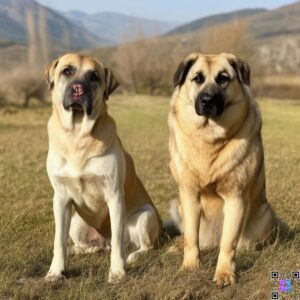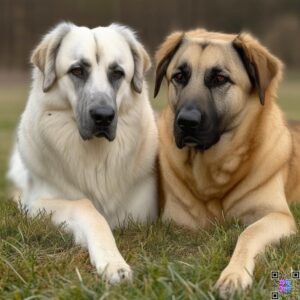Introduction
When it comes to livestock guardian dogs, the Turkish Boz and the Anatolian Shepherd stand out as two remarkable breeds with rich histories and impressive characteristics. Both breeds hail from Turkey, but they possess unique traits that make them suitable for different roles and environments. This article delves into the fascinating world of these two breeds, comparing their histories, physical characteristics, temperaments, and more. By the end, you’ll have a clearer understanding of whether the Turkish Boz or the Anatolian Shepherd is the right fit for you.
Understanding Turkish Boz and Anatolian Shepherd

The Turkish Boz is a traditional breed known for its agility and protective instincts. This breed has been used for centuries to guard livestock against predators, showcasing its loyalty and intelligence. The Anatolian Shepherd, on the other hand, is often recognized as a more robust breed, specifically bred for guarding flocks in the rugged terrains of Anatolia. While both breeds share a common ancestry and purpose, their differences in physical traits and temperament set them apart. The Turkish Boz Shepherd and the Anatolian Shepherd are two remarkable breeds that share a rich heritage rooted in Turkey’s pastoral traditions. While they may appear similar at first glance, each breed has distinct characteristics that set them apart. The Turkish Boz is known for its immense size, calm demeanor, and exceptional guarding instincts, making it a steadfast protector of livestock. On the other hand, the Anatolian Shepherd combines agility, intelligence, and endurance, excelling in both guarding and companionship roles. Together, these breeds embody the strength, loyalty, and resilience that define Turkey’s storied shepherd dogs. Understanding their unique traits helps appreciate their role in history and modern life.
Historical Background
The Turkish Boz has roots that trace back to ancient times, where it was primarily utilized by nomadic tribes to protect their livestock. Its adaptability to various environments has allowed it to thrive in different regions of Turkey. The Anatolian Shepherd, however, has a more documented history, with evidence suggesting its existence for over 6,000 years. This breed was developed specifically for the harsh conditions of Anatolia, where it learned to fend off wolves and other predators, making it a vital asset for shepherds.
The Turkish Boz Shepherd and Anatolian Shepherd are ancient breeds deeply rooted in Turkey’s pastoral and agricultural traditions. Both breeds share a rich history of protecting livestock and serving as indispensable companions to shepherds across the rugged landscapes of Anatolia and beyond.
Turkish Boz Shepherd
The Turkish Boz, a lesser-known but equally revered breed, traces its origins to rural regions of Turkey, particularly in areas where large-scale livestock farming thrived. Its name, “Boz,” translates to “gray” in Turkish, reflecting its common coat color. Boz Shepherds were selectively bred for their immense size, calm demeanor, and ability to deter large predators such as wolves and bears. Their loyalty and low-energy temperament made them ideal for guarding flocks over long periods with minimal supervision.
Anatolian Shepherd
The Anatolian Shepherd’s lineage stretches back thousands of years, believed to have descended from ancient Mesopotamian hunting and war dogs. They gained prominence as protectors of livestock, guarding sheep and goats from predators like wolves and jackals. Known for their endurance and independence, Anatolian Shepherds adapted to Turkey’s varied climates, from mountainous terrains to arid plains, showcasing their versatility and hardiness. Over time, they became beloved for their ability to think independently and perform their duties without constant human guidance.
Shared Heritage
Both breeds reflect Turkey’s deep connection to its agricultural roots. While the Boz Shepherd was prized for its massive size and guardian instincts in specific regions, the Anatolian Shepherd gained broader recognition for its adaptability and intelligence. Despite their differences, both breeds symbolize the pastoral lifestyle of Anatolia, where shepherd dogs were not just working animals but also vital to the survival of rural communities.
Today, these breeds continue to captivate dog enthusiasts and livestock owners worldwide, celebrated for their unique histories and unmatched loyalty.
Physical Characteristics
When comparing the physical characteristics of the Turkish Boz and the Anatolian Shepherd, several factors come into play. The Turkish Boz is known for its impressive stature. Typically weighing between 80 to 120 pounds, these dogs have a muscular build that conveys strength and agility. Their coats are usually short to medium-length, often in shades of fawn or brindle. The breed’s distinctive features include a broad head with erect ears and expressive eyes that reflect their intelligence.
- Size and Weight Comparisons: The Turkish Boz typically weighs between 70 to 90 pounds, while the Anatolian Shepherd can range from 90 to 150 pounds. This size difference can influence their roles in guarding and herding.
- Coat Color and Texture: The Turkish Boz often has a short, dense coat that can come in various colors, including fawn and brindle. In contrast, the Anatolian Shepherd usually has a longer coat, often seen in shades of cream, tan, or gray, with a characteristic black mask.
- Distinctive Features: The Turkish Boz is known for its athletic build and agility, making it an excellent choice for fast-paced environments. The Anatolian Shepherd, while also strong, is built more for endurance, allowing it to patrol large areas effectively.
Temperament and Behavior
The temperament of both breeds plays a crucial role in their effectiveness as livestock guardians. Bozs are known for their loyalty and protective instincts. They are naturally wary of strangers but are affectionate with their families. Proper socialization from an early age is crucial to ensure they develop into well-rounded companions. These dogs thrive on companionship and require regular exercise to maintain their health.
- General Temperament of Turkish Boz: The Turkish Boz is known for its intelligence and loyalty. They are protective of their family and territory, making them excellent watchdogs. Their agility also means they can react quickly to threats.
- General Temperament of Anatolian Shepherd: The Anatolian Shepherd is typically calm and patient, with a strong instinct to protect its flock. They are known for their independence, which can sometimes be mistaken for stubbornness.
- Comparison of Temperament: While both breeds are protective, the Turkish Boz tends to be more energetic and agile, whereas the Anatolian Shepherd is more laid-back yet equally vigilant.
Roles and Functions
Both breeds serve essential roles in livestock management, but their approaches can differ. In Turkey, the Turkish Boz is more than just a pet; it is a cultural icon. These dogs are often depicted in folklore and art, symbolizing strength and resilience. Their role as protectors of livestock has earned them respect among farmers who rely on their skills for safeguarding flocks.
- Working Roles of Turkish Boz: The Turkish Boz is often used in more dynamic environments where agility and speed are necessary. They excel in situations requiring quick responses to threats.
- Working Roles of Anatolian Shepherd: The Anatolian Shepherd is typically used in more extensive pastoral settings, where its endurance and ability to patrol large areas are invaluable.
Training and Socialization
Training is essential for both breeds to ensure they can perform their roles effectively.
- Training Techniques for Turkish Boz: Early socialization and consistent training are crucial for the Turkish Boz. They respond well to positive reinforcement and thrive in active environments.
- Training Techniques for Anatolian Shepherd: The Anatolian Shepherd requires a firm yet gentle approach to training. They benefit from routine and structure, helping them understand their roles better.
Health and Lifespan
Understanding the health issues and lifespan of both breeds can help potential owners make informed decisions.
- Common Health Issues in Turkish Boz: The Turkish Boz may be prone to hip dysplasia and other joint issues due to its size and activity level.
- Common Health Issues in Anatolian Shepherd: The Anatolian Shepherd can also face similar health concerns, including obesity if not exercised properly.
- Lifespan Comparison: Both breeds typically live between 10 to 13 years, depending on their health and care.
Choosing the Right Breed for You
When deciding between the Turkish Boz and the Anatolian Shepherd, several factors should be considered.
- Factors to Consider: Consider your living environment, activity level, and the specific roles you expect your dog to fulfill.
- Suitability for Different Owners: The Turkish Boz may be better suited for active families or individuals who can provide ample exercise, while the Anatolian Shepherd may be ideal for those looking for a more laid-back yet protective companion.
Size and Appearance
While both breeds are large and muscular, the Anatolian Shepherd tends to be heavier than the Turkish Boz. The Boz has a more athletic build compared to the stockier appearance of the Anatolian Shepherd.
Temperament Differences
Both breeds share protective instincts; however, the Turkish Boz is generally more sociable with strangers compared to the more reserved nature of the Anatolian Shepherd. This difference can influence how well each breed adapts to family life or social settings.
Working Abilities
Both breeds excel as guardians; however, their working styles may differ based on training methods. The Anatolian Shepherd’s independent nature may lead it to take initiative when guarding livestock without constant supervision.
Health Considerations
Both breeds are relatively healthy but can be prone to certain genetic conditions common in large dog breeds. Regular veterinary check-ups are essential for maintaining their health throughout their lives.
Choosing Between the Two Breeds
Deciding between a Turkish Boz or an Anatolian Shepherd involves considering various factors related to your lifestyle.
Factors to Consider
Potential owners should assess their living environment, activity level, and experience with dog training before making a decision. Both breeds require ample space to roam and exercise regularly.
Ideal Living Conditions
Both breeds thrive in homes with access to outdoor spaces where they can run freely. A rural setting or large backyard is ideal for these active dogs.
Training and Socialization
Early training is crucial for both breeds to ensure they develop into well-behaved companions. Consistent socialization helps them adapt better to different environments and people.
Both the Turkish Boz Shepherd and the Anatolian Shepherd are large, protective dog breeds native to Turkey, but they have distinct differences in terms of training, socialization, and general temperament. Here’s a comparison of both breeds:
1. Turkish Boz Shepherd
- Origin: The Turkish Boz Shepherd (also known as “Boz”) is a working dog that was bred to guard livestock in the mountainous regions of Turkey. They are highly protective and have a strong instinct to guard their home or flock.
- Temperament: The Boz Shepherd is known for its calm, composed, and somewhat aloof nature, but they are very protective and loyal to their families. They tend to be reserved and independent, making them less eager to please compared to other breeds.Training:
- Challenges: Training can be a challenge, as they are independent thinkers and can be stubborn. Early training is essential, and consistent, firm leadership is needed.
- Methods: Positive reinforcement works best, but training should be done with a calm and patient approach. Harsh methods can backfire with this breed. Socialization at a young age is crucial to prevent them from becoming overly territorial or aggressive.
- Obedience: While intelligent, they might not always be highly responsive to commands. They tend to do things on their terms, which means they might ignore commands if they feel it’s not necessary.
Socialization:
- The Boz Shepherd is naturally protective, and without proper socialization, they may become territorial or suspicious of strangers. Early and extensive socialization with various people, animals, and environments is essential to ensure they are well-adjusted and not overly aggressive.
- Due to their independent nature, they might not seek interaction with strangers unless they are trained to do so. They are loyal to their family but can be distant from others.
2. Anatolian Shepherd
- Origin: The Anatolian Shepherd is also a livestock guardian breed, originally bred to protect flocks from predators like wolves and bears in the Anatolian plateau in Turkey.
- Temperament: The Anatolian Shepherd is known for its calm, confident demeanor. They are intelligent, protective, and alert but often more adaptable and easier to train than the Boz Shepherd. They are also very independent but can be more willing to please when trained properly.
Training:
- Challenges: Like the Boz, the Anatolian Shepherd can be independent and sometimes stubborn, but they are generally more responsive to training. Early socialization and firm but gentle training are essential for this breed.
- Methods: Anatolians respond well to positive reinforcement, and training should include firm consistency, but they are more likely to respect leadership compared to the Boz Shepherd. This breed is also more likely to perform tasks for their owners rather than on their terms.
- Obedience: While they may not be as eager to please as some breeds, they are generally more trainable than the Boz Shepherd. With early socialization and consistent training, they can become obedient, especially when they understand their role within the household.
Socialization:
- Like the Boz Shepherd, Anatolian Shepherds are naturally protective. They can be aloof with strangers but can be friendly and affectionate with their families. Early socialization is key to preventing them from becoming overly suspicious or aggressive towards unfamiliar people or animals.
- If well-socialized, the Anatolian Shepherd is likely to get along with other pets and animals, including other dogs, as long as they aren’t viewed as a threat.
Comparison of Training & Socialization:
- Training Ease: The Anatolian Shepherd is generally easier to train than the Turkish Boz Shepherd due to its slightly more cooperative and responsive nature. Both breeds need consistent, patient, and firm training, but Anatolians may have an edge in being more willing to engage with their owners.
- Socialization Needs: Both breeds require early and ongoing socialization to ensure they are well-adjusted around strangers, children, and other animals. However, the Boz Shepherd might have a harder time being as social as the Anatolian Shepherd due to its more reserved and territorial nature.
- Protectiveness: Both breeds are extremely protective of their families and can be wary of strangers. However, the Anatolian Shepherd may be a bit more adaptable in different social settings, whereas the Boz Shepherd is often more reserved, which can make it harder to manage in public situations.
- Suitability for Families: The Anatolian Shepherd tends to be a better fit for families with children or multiple pets, as they are often more adaptable and less likely to be overly aggressive without proper training. The Boz Shepherd may require more time and patience to get along with other pets or strangers, but it can still be an excellent companion for an experienced owner.

FAQs
1- What is the main difference between Turkish Boz and Anatolian Shepherd?
The main difference lies in their physical characteristics and temperament. The Turkish Boz is generally more agile and energetic, while the Anatolian Shepherd is larger and more laid-back.
2- Which breed is better for guarding livestock?
Both breeds are excellent guardians, but the choice depends on the specific environment and needs. The Turkish Boz is better for dynamic situations, while the Anatolian Shepherd excels in extensive areas.
3- Are Turkish Boz and Anatolian Shepherd good family pets?
Yes, both breeds can be good family pets, but they require proper training and socialization. Their protective nature makes them great companions.
4- How much exercise do these breeds need?
Both breeds require regular exercise, with the Turkish Boz needing more due to its energy levels. Daily walks and playtime are essential.
5- What is the average lifespan of each breed?
Both the Turkish Boz and the Anatolian Shepherd typically live between 10 to 13 years, depending on their health and care.
6- Where can I find reputable breeders for these breeds?
Reputable breeders can often be found through breed clubs and associations dedicated to Turkish Boz and Anatolian Shepherds. It’s essential to research and visit breeders to ensure they follow ethical breeding practices.
Conclusion
In conclusion, both the Turkish Boz and the Anatolian Shepherd are remarkable breeds with unique qualities that make them exceptional livestock guardians. Understanding their differences in history, physical characteristics, temperament, and roles can help potential owners make the right choice for their needs. Whether you choose the agile Turkish Boz or the steadfast Anatolian Shepherd, both breeds will offer loyalty, protection, and companionship.
